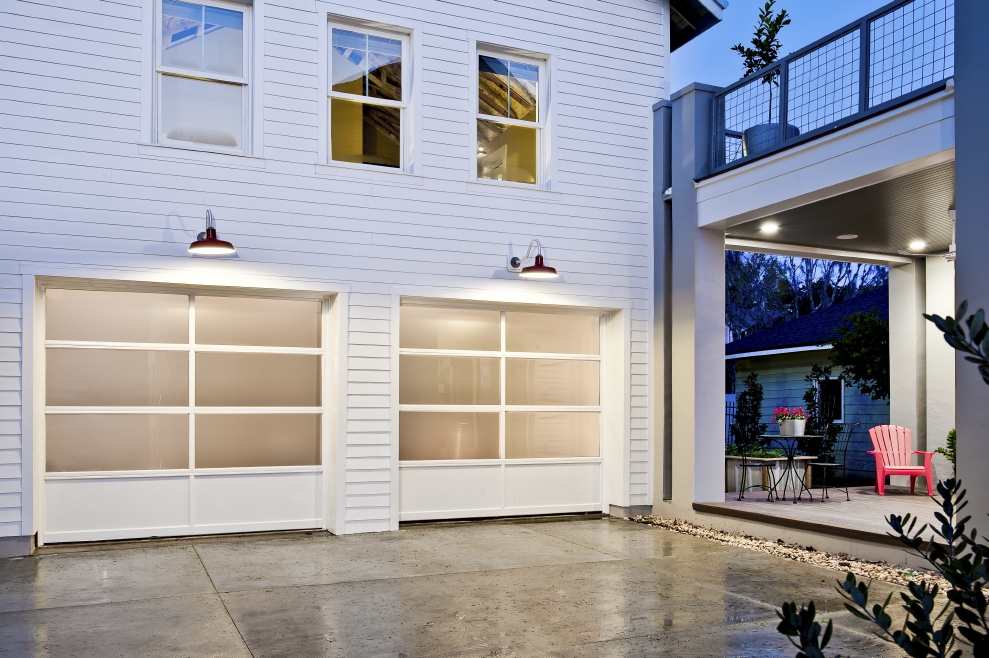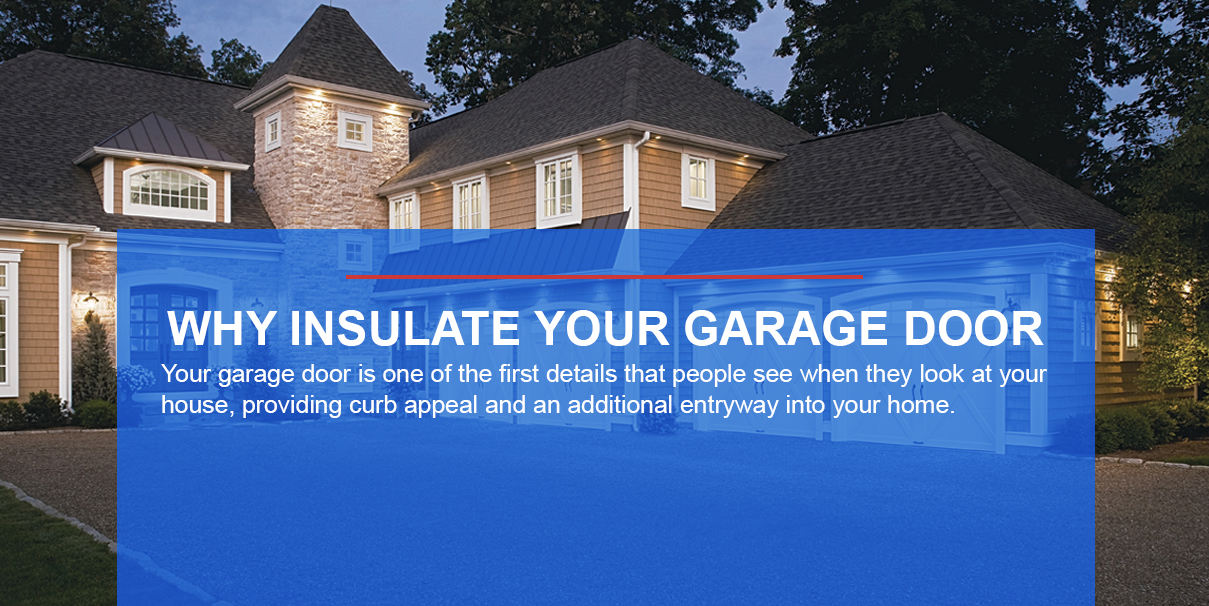
Table of Contents
Why Insulate Your Garage Door?
Your garage door is one of the first details that people see when they look at your house, providing curb appeal and an additional entryway into your home. Since your garage door opening is usually the biggest in your home, it can also be an area of extreme heat and energy loss. This results in drafty rooms in the winter, hot and humid living areas in the summer and a lot of money wasted on heating and cooling. Many homeowners, especially those located in areas with temperature or weather extremes, may wonder if they should insulate their garage door to help alleviate these issues. Garage insulation provides many benefits in addition to saving you money by increasing energy efficiency.
There are several ways to insulate garage doors including installing it yourself with a DIY insulation kit, having it done by a professional or choosing a new insulated garage door that can not only increase your home’s comfort and energy efficiency but also add to its beauty. Learning about garage door insulation’s R-value along with the differences between polystyrene and polyurethane insulation, the two most commonly used garage door insulation types, can help you make an informed decision about the best way to insulate your garage door.
The Benefits of Insulating a Garage Door
Depending on the type and location of your garage space, an insulated garage door can provide many benefits. Homes with attached garages may see the most benefit from insulating the door, but even detached garage spaces can benefit from being insulated, especially in areas with extreme climates.
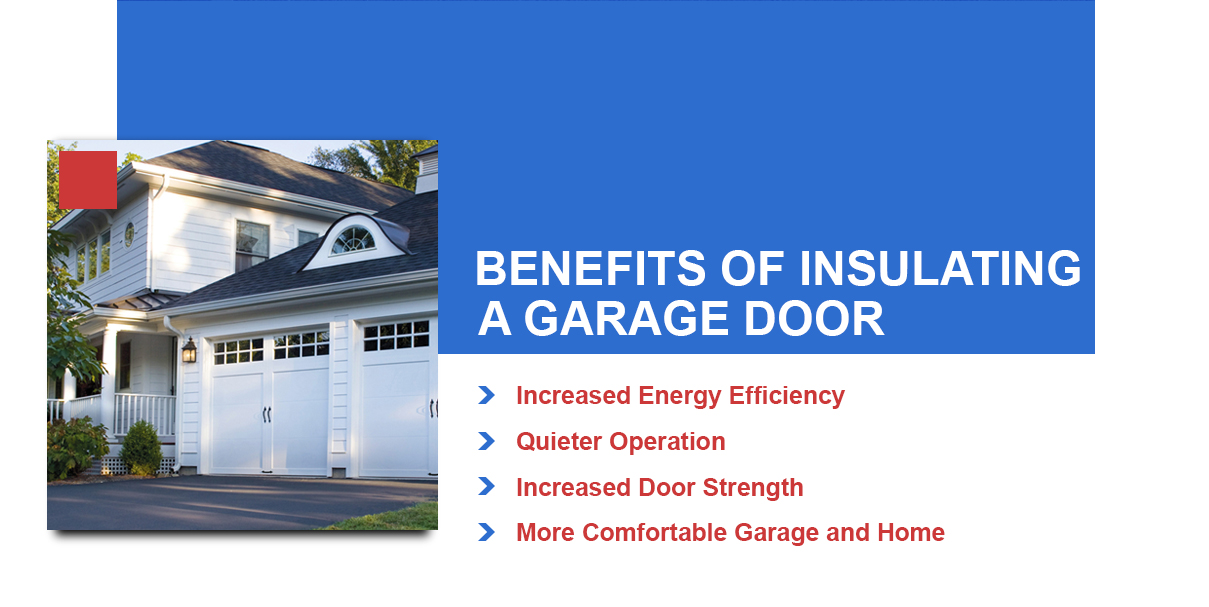
Benefits of insulating your garage door include:
1. Increased Energy Efficiency
An insulated garage door helps reduce energy loss by keeping heat from escaping in the winter and preventing hot air from entering your garage in warmer temperatures. This enhanced climate control and moderate temperature inside the garage reduces the amount of energy needed to heat and cool your home. The result can be reduced heating bills and cooling costs since less conditioned air will escape from your home and be needed to maintain a comfortable climate. If you have an attached garage, an insulated garage door can help with hot and cold air entering areas of your homes such as hallways, high-traffic areas and rooms above the garage. Insulated garage doors minimize the heat loss that happens even while they are closed.
2. Quieter Operation
Insulated garage doors operate much quieter than non-insulated doors. The insulation adds to the strength of the door and reduces creaks and rattles. While an insulated door can absorb much of the sound and vibration caused by the operation, it’s essential to have the track mechanism — including chains, rollers, hinges and springs — inspected by a professional if they are making noise. A quieter operation is especially beneficial if you usually use your garage door as an entryway or if there are living areas above or next to the garage. Insulated doors also act as a sound barrier, muffling the sounds from outside.
3. Increased Door Strength
An insulated garage door has more overall strength than a non-insulated door. It can stand up to constant opening and closing and is more resistant to damage and dents from vehicles, kids, weather and everyday use. Insulated garage doors are also resistant to the rusting that occurs in many non-insulated, single layer doors. Today’s insulated garage doors are typically made with steel frames filled with solid insulation in between, making them both sturdy and lightweight. They are made to be long-lasting and resist the elements such as heat, sun and wind that can shorten the lifespan of non-insulated doors.
4. More Comfortable Garage and Home
An insulated garage door makes for a more comfortable environment in both your home and garage. It will minimize cold drafts that come through the house from the garage and keep hot air out in the warmer seasons. Garage doors with a higher level of insulation can even allow you to use your garage throughout all of the seasons. Although to be able to truly use your garage as an additional living area, you will need to insulate the walls and ceiling and install drywall, having an insulated door makes a better environment for storage, vehicles, crafts and hobbies or just getting in and out of the house. With the long list of advantages, a new insulated garage door easily ranks at the top as one of the best home improvement projects that you can invest in.
Do Insulated Garage Doors Make a Difference?
Having an insulated garage door can make a positive difference in both your garage and indoor living spaces. Insulated garage doors make the most difference in homes with attached garages, especially those with bedrooms above or next to the garage. They can also make a difference in detached garages since they make the indoor temperature more comfortable. The term “thermal boundary” refers to the line between unconditioned outside air and conditioned indoor air. A garage with an insulated door provides a better thermal boundary, preventing a blast of cold air from entering the adjacent rooms and rooms over the garage.
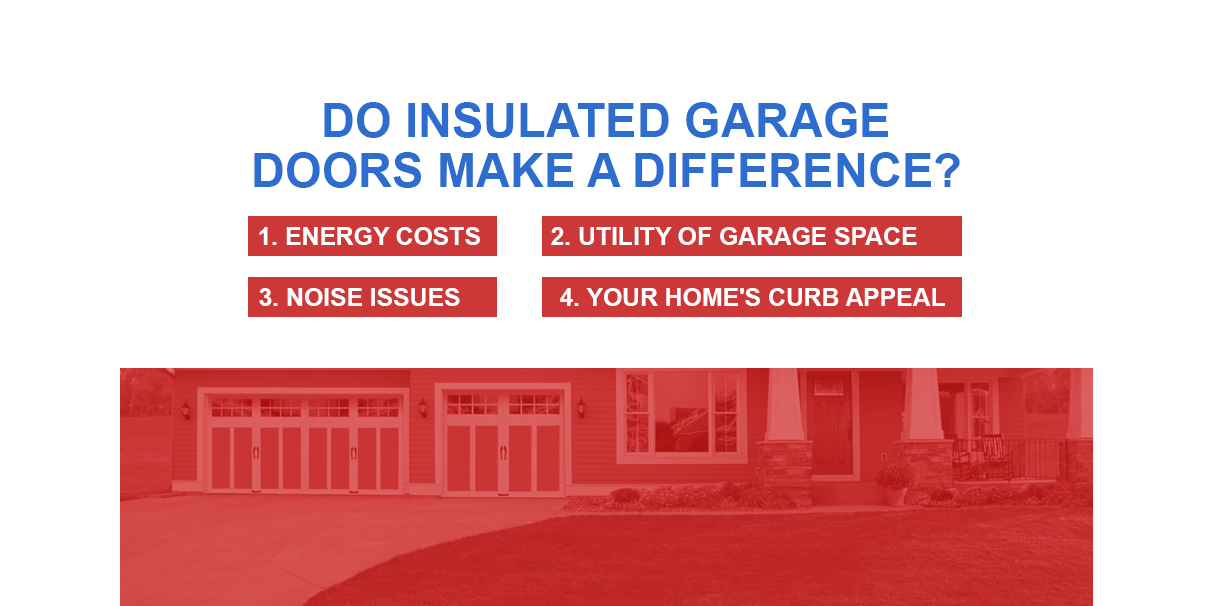
Insulated garage doors can also make a difference with:
1. Energy Costs
You may see a significant energy cost savings after insulating your garage door or purchasing one that is already insulated. The amount of energy savings you will see depends upon where you live, and how hot or cold you keep your home. Homeowners in areas with extreme temperatures often see the most difference. Although insulated garage doors are usually more costly than non-insulated doors, the money will be well spent between the savings on energy bills and the fact that a garage door replacement yields an 85 percent return on investment when selling your home.
2. Utility of Garage Space
Insulated garage doors can provide a warmer garage space. In fact, an insulated garage door can make the temperature inside the garage over 20 degrees warmer than the outside air. While the degree difference varies according to the door’s R-value, this can sometimes mean the difference of a garage at freezing and above freezing temperatures. For many homeowners who live in frigid climates, a freezing garage means frozen pipes and a car that won’t start. Since many homeowners use their garage space for storage, an insulated door can provide a more appropriate environment for storing items that need to be kept from excessive moisture and temperature extremes such as paint, oils, photos and food products.
3. Noise Issues
Insulated garage doors can actually be about three times quieter than non-insulated garage doors and can reduce noise by up to 16 decibels. This is helpful for home occupants who reside in rooms above or next to the garage. Not only does insulating the garage door result in less rattling, but there is also more sound absorption from outside noise.
4. Your Home’s Curb Appeal
Insulated garage doors are available in a wide variety of colors, materials and styles that can add significantly to the beauty of your home. They are available both with and without insulated windows and with a number of options including window placement, number and type of panels and texture options.
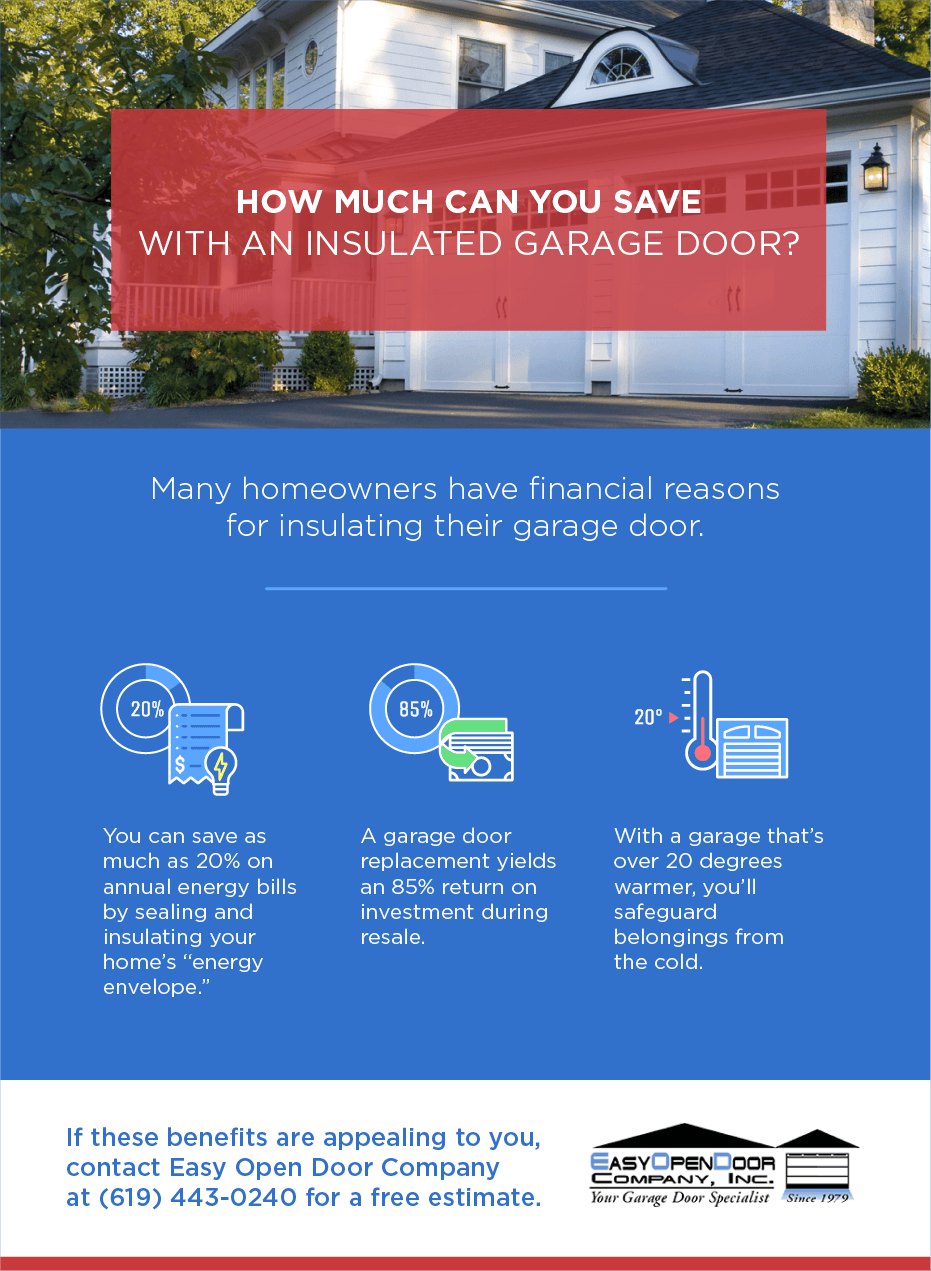
Types of Insulated Garage Doors
There are several different types of insulated garage doors. The most common types include:
1. Steel Insulated Garage Doors
Steel is durable, affordable and made to resist warping, cracking and weather exposure. It can be made with a texture that looks like wood and painted in a color of your choice. Insulated steel garage doors consist of a double layer of steel with insulation sandwiched between. These doors are frequently constructed with additional composite materials such as faux wood cladding.
2. Wood Insulated Garage Doors
Insulated wood doors give your home a natural, warm and rich look. Made of woods such as cedar, hemlock and redwood, insulated wood garage doors consist of two layers of wood, or a layer of wood with a layer of wood veneer, and a layer of insulation between.
3. Aluminum Insulated Garage Doors
Aluminum is a lightweight material that is long-lasting and resistant to rust and corrosion, but easy to dent. An insulated aluminum garage door consists of a double layer of aluminum with a layer of insulation between, adding some protection against dents.
4. Fiberglass Insulated Garage Doors
Fiberglass is also a lightweight material that does not corrode although it can be easily damaged. Fiberglass garage doors can be molded to look like wood. Insulated fiberglass doors consist of two layers of fiberglass sheeting over a steel frame, with a layer of insulation between.
When looking at the different types of garage door insulation, it’s helpful to know what the numbers that measure the insulation’s effectiveness mean. You will typically hear the term R-value used when referring to the level of energy efficiency, but many people wonder what that term actually means.
Features of an Insulated Garage Door To Know
What is R-Value?
R-value is the most widely used measurement of insulation and refers to a barrier’s ability to slow the transmission of heat. The higher the R-value the better, as a higher number means a slower transmission of heat. As the insulation R-value goes up, so does the degree of energy efficiency. This range goes from R-8 to R-32, with many homeowners opting for garage doors around R-16.
What is U-Factor?
U-factor is less commonly used and refers to the flow of heat through a material. When considering a garage door’s U-factor, a lower number is better.
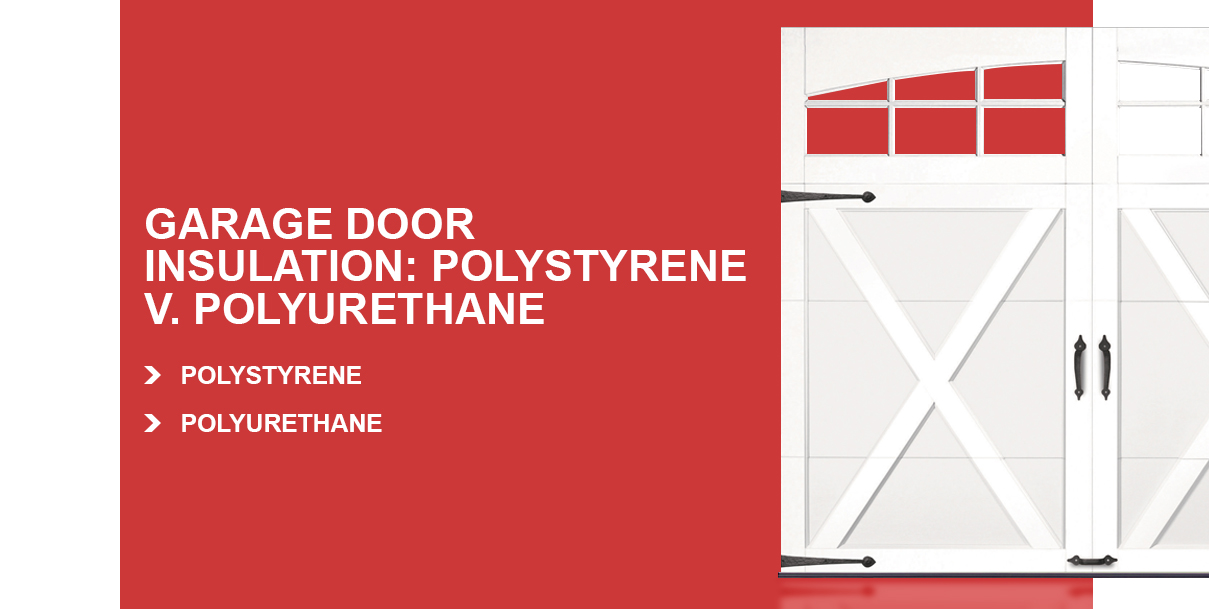
Garage Door Insulation: Polystyrene v. Polyurethane
Polystyrene and polyurethane are the two main insulation materials available in insulated garage doors. When considering polystyrene vs. polyurethane garage door insulation, it’s important to know the difference between the two:
1. Polystyrene
This material, which comes in the form of rigid panels with a vinyl back, is commonly used in many garage doors. Polystyrene is the material that is used in aftermarket garage door insulation kits. The panels are placed behind single-layer garage doors or in between the layers of a two-layer garage door. While the addition of polystyrene garage door insulation will quiet the door’s operation and add some energy efficiency, it is not as energy efficient as polyurethane. It can also come apart over time due to being repeatedly bent and folded with door operation.
2. Polyurethane
Polyurethane garage door insulation, used in Clopay’s Intellicore Insulation Technology, is a foam injected between the layers of the door. The polyurethane foam expands into every area of the door and also bonds to the door’s frame. This results in an extremely strong door that is less susceptible to dents. Polyurethane foam provides the highest level of sound isolation and energy efficiency and is ideal for homeowners who live in very hot or cold climates or use their garage door as a primary home entrance.
Most modern garage doors come with single-, double- or triple-layer construction:
- Single-layer garage doors: This type of door is non-insulated and, as its name suggests, made of a single panel. They are sturdy and affordable and provide basic protection for storing your car in the garage.
- Double-layer garage doors: Double-layer garage doors add a layer of polystyrene or polyurethane foam against a thin backing material. They provide more energy efficiency and soundproofing than single layer doors, along with more structural integrity. As the level of construction and durability goes up, so does the price.
- Triple-layer garage doors: Triple-layer doors are the best quality. They feature a layer of thick polystyrene or polyurethane foam insulation between two layers of steel, wood or other material. They also have an additional galvanized skin that protects the insulation. These doors do have a higher price, but they also provide the highest energy efficiency, sturdiness and sound buffering.
While an insulated garage door helps to moderate the temperature inside the garage space, it also needs to have appropriate weatherstripping and vinyl weather seal that runs along the bottom of the door to further keep out insects, small animals, air, moisture and weather. You can insulate a garage further by finishing the walls and ceiling with insulation and drywall and caulking around windows. If you’re considering insulating your garage, keep in mind important factors such as the climate in which you live and the elements such as sun or wind to which your door will be exposed, to determine the best type of insulation to use.
Insulation Options – DIY Vs. Hiring a Professional
Since there are a variety of self-install garage door insulation kits on the market today, many homeowners wonder if they should install their own or hire a professional. While the do-it-yourself insulation methods and kits are inexpensive, they should not be used by anyone who is inexperienced with this kind of project. The process of insulating a garage door must be precise, and a shoddy DIY job can result in a multitude of other problems including:
- Mismeasured or misaligned panels compromising the door’s safety and operation.
- Needing to redo the job shortly after the initial install, costing additional time and money.
- Adding additional weight that can wear out your springs and make the door unsafe.
It’s essential that measurements are accurate as incorrect measurements can cause the insulation panels to flake, shift and even get in the way of the door’s normal operation. DIY insulation kits applied to the back of the door tend to flake and break off over time. On a door that is used several times a day, the insulation will wear off quicker, requiring you spend the money and time all over again.
Adding insulation to your garage door also adds weight that your springs and opener may not be able to handle. This can be extremely dangerous and cause a risk of the door unexpectedly giving way when people, pets or vehicles are nearby. For this reason, it’s recommended to have your door looked at by a professional who can adjust the spring tension if needed.
If you’re unsure about how to insulate your garage door, it’s always best to call a professional who will properly get the job done. Not only will the job be done right, but it alleviates the hassle of having to do it yourself. Garage door professionals can also suggest different ways to insulate your door such as applying a weather seal.
Of course, if you’re replacing your current garage door with a new one that has a higher insulation value, you’ll need a professional to install it.
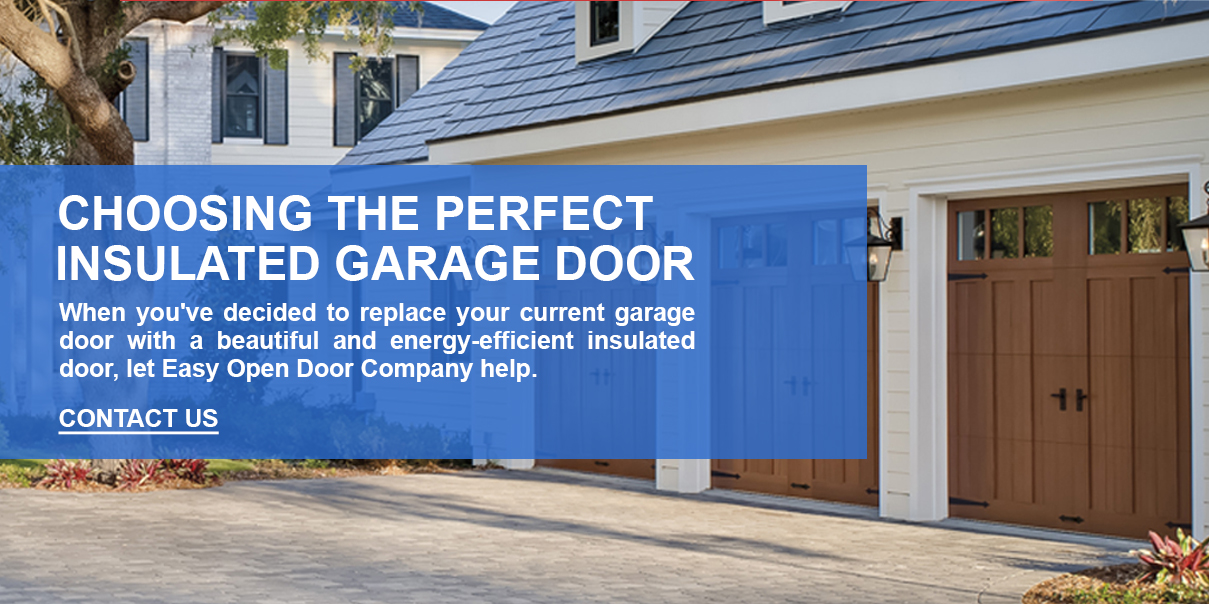
Choosing the Perfect Insulated Garage Door
When you’ve decided to replace your current garage door with a beautiful and energy-efficient insulated door, let Easy Open Door Company help. We can install your beautiful new garage door quickly and efficiently. We are proud to be a Premier Clopay dealer, family-owned and serving the San Diego area for nearly 40 years. Choose from our large selection of beautiful Clopay garage doors and LiftMaster openers. Whether you’re looking to keep out the winter chill or just want to add to the beauty of your home, we have the perfect insulated garage door for you. Contact us, your trusted insulated garage door installers, for a free estimate today. We also provide garage door opener installation and replacement. Easy Open Door proudly serves all of the greater San Diego, including El Cajon, Chula Vista and more.


